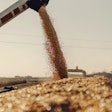
As of the writing of this article, some of us in the grain merchandising community find ourselves in what has unfortunately become a very familiar scenario. Farmers with unpriced old crop corn, which has up to this point in the marketing year been languishing in the farm bin or on a storage/delayed price (DP) contract, are coming to terms with the realities of both the market and the calendar as we approach what appears to be
另一个丰收。我说熟悉是因为that last statement could’ve been said for the corn crops of 2014, 2015 and 2016.
What has many country grain buyers scratching their heads is 1) farmers have a better idea of what it takes to sell their corn above breakeven this year compared to past years, and 2) the market has presented more rallies and thus more selling opportunities this summer than in recent years.
So, big crops, known breakeven levels and summer rallies, but no selling; what gives?
I tend to think that our current grain origination ills are a sort of marketing hangover from the ’07 through ’13 years in which both the producer and merchandiser were often rewarded without being proactive. If not rewarded, they were certainly not significantly penalized, profitability wise, by taking a wait and see approach to grain marketing. With the increasing production and carryout levels of the last few years, today’s price environment is as different from ’07 to ’13 as the Sahara is from the Amazon. Similar to the way that crop input prices lag a downturn in the grain markets, much-needed changes in selling behaviors are also lagging the reality of the current situation in which the market trades below many producers’ level to be profitable for a majority of the marketing year. So, what does all this have to do with grain buying policies?
首先,让我们确保我们都清楚what we are talking about when we mention grain buying policies from the merchandiser’s perspective. Essentially, as a merchandiser or originator, you or your company have a certain set of guidelines and a specific system for buying grain. This includes, but is not limited to: contracts offered, service fees (e.g., DP fees, HTA charges, etc.), bid structure, discount schedules, farm marketing programs and general pricing policies (e.g., when DP bushels must be priced or how many times a Basis Only contract can be rolled). Companies tend to arrive at their policies either by inertia (we’ve always done it this way), by competition (I must do it if the guy down the road is doing it) or because it presents a win-win scenario for both farmer and elevator (farmer sells when cash price says to, elevator sells when basis says to). While an in-depth discussion of these topics would take up more space than this article allows, I would like to present the case for why poor grain buying policies, in general, have contributed to the recent farm marketing malaise.
让我们在时间旅行的夏天2015. Producers appear to be heading for a good fall crop, have a good grasp on their costs and are waiting on a timely summer rally to consider getting grain sold. Buyers in the country are also waiting for that rally, hoping for the chance to get some new crop ownership. Besides watching the market, not much action is being taken either in the form of a structured plan for the farmer to sell grain or an earnest attempt on the part of the originator to buy grain; no firm offers/targets have been entered by the farmer nor asked for by the buyer. The much anticipated rally appears, but with no plan for locking in profitability when available, many producers let the pendulum of emotion swing 180 degrees from “it’s so low I don’t know why I even planted this stuff!” to “how high can this thing go?!” without taking any positive action at all. As a result, the country elevator doesn’t get much corn bought.
As we get into harvest, prices have dropped and to “compete” for the overabundance of bushels, merchandisers either initiate or retaliate in a bidding war, forcing nearly all markets to pay a higher harvest basis for the corn than is warranted for such a supply and demand setup (read: more bushels than space).
Even this running up of the basis doesn’t accomplish its goal of buying more bushels, as the cash price is still too low to cash flow for many farmers. So whatever long position the elevator has coming out of harvest is owned at a 10 to 15 cents higher basis than was anticipated.
As we shift to the post-harvest period of mid spring,cash prices remain low and farmer selling is light. End users, needing a steady supply of corn each month, raise basis in typical fashion to attract commercial bushels, but to no avail. The merchandisers that paid up too much at harvest, in an effort to meet the margin goals that owning typical harvest basis would allow, hold out for a push that never comes and subsequently do not sell until much later. After receiving no help from either the futures or the basis, some end users resort to offering free DP to get corn moving to them; it works. The thing about free DP is that in a carry market like corn typically trades in, it effectively (and artificially) caps the basis; if that mechanism is bringing much needed corn into the pipeline, then there is little reason for the basis to do any heavy lifting and it stagnates at best. This result frustrates both the farmer when he finally prices out his DP corn, and the country merchandiser, who not only overpaid the market for his corn but now must face the prospect of selling the basis at a discount. Farmer and elevator alike are caught in a cost/price squeeze.
Fast forward to the summer of 2016. The previous year’s scenario repeats itself in nearly every aspect; producers are distracted by their need to sell old crop bushels and forego selling new crop during the rally in June (which turned out to be the only rally that summer).
Grain merchandisers don’t have solid, proactive farm marketing programs to get basis bought by harvest at profitable levels. After harvest, end users, seemingly having no other recourse, entice bushels to the market through non-price signals. The main change this past year is that end users began offering free DP earlier in the marketing season, some as early as February.
As we approach harvest 2017, this same storyline is playing out once again. One reaction has been to (unwittingly perhaps) intensify the problem by pushing reactive buying policies that get grain into the supply channels at ANY cost, be it free DP programs that last 18 months, the perpetual rolling of basis contracts or the selling of questionable grain contracts offering the farmer a cheap way (or a premium) to get out of this hole. These are band aid solutions at best and do not address the underlying issues that led to this situation.
The news isn’t all bad; another reaction to this recent cycle has been for merchandisers to take an extremely proactive approach in helping their producers get more profitable forward sales made ahead of harvest as well as getting basis ownership levels more in line with the type of large crop market we are heading into. This approach accomplishes a few things. First, it allows the farmer to have a significant portion of his production sold ahead of time, whether for harvest or post-harvest delivery, that is cash-flow positive and clears their mind to focus on the next crop. Secondly, it gives the merchandiser the opportunity to make a better margin within the grain value constraints of their given market. Finally, it permits the end user to get bushels sourced using normal price signals instead of relying on an artificial mechanism to move grain. The best part of all this is that no one is left with a bad taste in their mouth when all transactions are complete!
As a grain merchandiser, if you can achieve the goal of implementing and maintaining a proactive system of grain buying policies, not only will you go a long way in securing the relationships on both sides of the bushel, you will also find yourself able to maximize your ability to generate the greatest margins out of your market’s basis curve. ❚
Roger Gattis, a grain merchandising specialist with White Commercial Corp., joined the WCC team in 2014, but has been a part of the WCC family since 2003. Roger, his wife Savanna and daughter Maizie reside in Lenexa, KS. He can be reached at 816-666-8708 or(电子邮件保护).





















